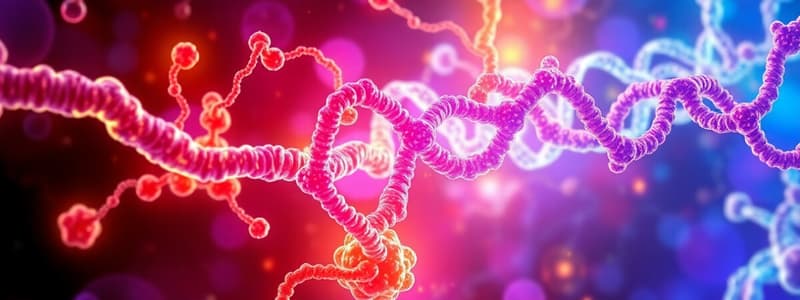Podcast
Questions and Answers
How do nucleosides and nucleotides differ in their molecular composition?
How do nucleosides and nucleotides differ in their molecular composition?
- Nucleosides contain a nitrogenous base, while nucleotides do not.
- Nucleotides contain a sugar, while nucleosides do not.
- Nucleotides contain a phosphate group, while nucleosides do not. (correct)
- Nucleosides contain a phosphate group, while nucleotides do not.
Which of the following is NOT a source for purine and pyrimidine synthesis?
Which of the following is NOT a source for purine and pyrimidine synthesis?
- Salvage pathways
- Glycolysis (correct)
- Diet
- De novo synthesis
What main purpose do salvage pathways serve in nucleotide metabolism?
What main purpose do salvage pathways serve in nucleotide metabolism?
- Breaking down excess nucleotides for excretion.
- Converting ribonucleotides into deoxyribonucleotides.
- Creating nucleotides from scratch using basic metabolites.
- Recycling nucleobases to restore nucleotide availability. (correct)
What role do purines and pyrimidines play in the bioenergetics of a cell, beyond serving as building blocks of genetic material?
What role do purines and pyrimidines play in the bioenergetics of a cell, beyond serving as building blocks of genetic material?
During which phase of the cell cycle would you expect to see the highest levels of purine and pyrimidine biosynthesis?
During which phase of the cell cycle would you expect to see the highest levels of purine and pyrimidine biosynthesis?
The conversion of UMP to UDP is catalyzed by what kind of enzyme?
The conversion of UMP to UDP is catalyzed by what kind of enzyme?
What is the initial precursor molecule in pyrimidine synthesis?
What is the initial precursor molecule in pyrimidine synthesis?
Which enzyme is responsible for catalyzing the committed step in de novo pyrimidine biosynthesis?
Which enzyme is responsible for catalyzing the committed step in de novo pyrimidine biosynthesis?
Which of the following enzymes is inhibited by 5-fluorouracil (5-FU), a common chemotherapeutic agent?
Which of the following enzymes is inhibited by 5-fluorouracil (5-FU), a common chemotherapeutic agent?
Which enzyme is directly responsible for converting ribonucleotides to deoxyribonucleotides?
Which enzyme is directly responsible for converting ribonucleotides to deoxyribonucleotides?
Which of the following is the rate-limiting enzyme in de novo purine synthesis?
Which of the following is the rate-limiting enzyme in de novo purine synthesis?
In the context of purine synthesis, what is the role of Adenylosuccinate lyase?
In the context of purine synthesis, what is the role of Adenylosuccinate lyase?
Which of the following molecules inhibits the activity of ribonucleotide reductase?
Which of the following molecules inhibits the activity of ribonucleotide reductase?
What is the primary function of adenylate kinase?
What is the primary function of adenylate kinase?
In the coupling reaction to hydrolysis of ATP, what term describes the state of most synthesis pathways in organisms without ATP hydrolysis?
In the coupling reaction to hydrolysis of ATP, what term describes the state of most synthesis pathways in organisms without ATP hydrolysis?
An increase in which of the following intracellular compounds typically triggers an increase in ATP production?
An increase in which of the following intracellular compounds typically triggers an increase in ATP production?
A 9-month-old presents with orange deposits in their diaper, is underweight, and has involuntary movements. Which disorder does this align with?
A 9-month-old presents with orange deposits in their diaper, is underweight, and has involuntary movements. Which disorder does this align with?
Lesch-Nyhan syndrome results from a deficiency in which of the following enzymes?
Lesch-Nyhan syndrome results from a deficiency in which of the following enzymes?
What metabolic abnormality is typically observed in patients with Lesch-Nyhan syndrome?
What metabolic abnormality is typically observed in patients with Lesch-Nyhan syndrome?
Which of the following is a common clinical characteristic associated with Lesch-Nyhan syndrome?
Which of the following is a common clinical characteristic associated with Lesch-Nyhan syndrome?
A child with megaloblastic anemia, orotic acid crystalluria, and cardiac malformations is most likely suffering from which of the following disorders?
A child with megaloblastic anemia, orotic acid crystalluria, and cardiac malformations is most likely suffering from which of the following disorders?
Hereditary orotic aciduria is caused by a defect in which enzyme?
Hereditary orotic aciduria is caused by a defect in which enzyme?
How is hereditary orotic aciduria typically treated?
How is hereditary orotic aciduria typically treated?
What would you expect to find in a patient with hereditary orotic aciduria?
What would you expect to find in a patient with hereditary orotic aciduria?
In orotic aciduria, the administration of uridine improves the patient's condition. What is the purpose of uridine adminstration?
In orotic aciduria, the administration of uridine improves the patient's condition. What is the purpose of uridine adminstration?
Flashcards
What is a nucleoside?
What is a nucleoside?
Base + sugar
What is a nucleotide?
What is a nucleotide?
Base + sugar + phosphate
De Novo synthesis
De Novo synthesis
Synthesis from basic metabolites
Salvage pathways
Salvage pathways
Signup and view all the flashcards
What do salvage pathways require?
What do salvage pathways require?
Signup and view all the flashcards
Catabolic pathways
Catabolic pathways
Signup and view all the flashcards
What is the role of Purines and Pyrimidines?
What is the role of Purines and Pyrimidines?
Signup and view all the flashcards
When are purine and pyrimidine levels high?
When are purine and pyrimidine levels high?
Signup and view all the flashcards
Uridine monophosphate (UMP) synthesis
Uridine monophosphate (UMP) synthesis
Signup and view all the flashcards
What enzyme catalyzes the committed step in pyrimidine synthesis?
What enzyme catalyzes the committed step in pyrimidine synthesis?
Signup and view all the flashcards
How is CTP made?
How is CTP made?
Signup and view all the flashcards
What is Thymidylate synthase (TYMS)?
What is Thymidylate synthase (TYMS)?
Signup and view all the flashcards
What enzyme regulates Purine synthesis?
What enzyme regulates Purine synthesis?
Signup and view all the flashcards
What is IMP?
What is IMP?
Signup and view all the flashcards
What enzyme is rate limiting in GMP synthesis?
What enzyme is rate limiting in GMP synthesis?
Signup and view all the flashcards
What enzyme is rate limiting in AMP synthesis?
What enzyme is rate limiting in AMP synthesis?
Signup and view all the flashcards
Where are ATP's high energy bonds?
Where are ATP's high energy bonds?
Signup and view all the flashcards
How is ATP generated?
How is ATP generated?
Signup and view all the flashcards
What is ATP used for?
What is ATP used for?
Signup and view all the flashcards
What triggers increased ATP production?
What triggers increased ATP production?
Signup and view all the flashcards
Why does Lesch-Nyhan occur?
Why does Lesch-Nyhan occur?
Signup and view all the flashcards
What occurs with Lesch-Nyhan syndrome?
What occurs with Lesch-Nyhan syndrome?
Signup and view all the flashcards
Other indicators of Lesch-Nyhan syndrome
Other indicators of Lesch-Nyhan syndrome
Signup and view all the flashcards
What causes hereditary orotic aciduria?
What causes hereditary orotic aciduria?
Signup and view all the flashcards
How do you treat hereditary orotic aciduria?
How do you treat hereditary orotic aciduria?
Signup and view all the flashcards
Study Notes
- Nucleosides consist of a base and a sugar.
- Nucleotides consist of a base, a sugar, and a phosphate group.
Purine and Pyrimidine Sources
- De novo synthesis involves creating purines and pyrimidines from scratch.
- Salvage pathways recycle existing purines and pyrimidines.
- Diet provides a source of purines and pyrimidines
Overview of Metabolic Processes Involving Purines and Pyrimidines
- De novo Synthesis utilizes basic metabolites.
- Salvage pathways serve to restore availability.
- Catabolic pathways are for excretion to reduce toxicity.
- Conversion of ribonucleotides into deoxyribonucleotides (precursors of DNA).
Purine and Pyrimidine Biosynthesis
- Biosynthesis is highly regulated due to its high energy cost.
- Synthesis levels vary greatly depending on the need, with high levels occurring during the S-phase, in growing tissues, stem cells, actively proliferating cells, and during wound healing.
- It provides the building blocks of genetic material and serves as key players in bioenergetics.
- They serve as components of coenzymes including NAD+/NADH and NADP+/NADPH.
- They serve as precursors to nucleotides.
- Synthesis can be from metabolic intermediates, therefore they are not required in diet.
Pyrimidine Synthesis
- Pyrimidine base is made first and then the sugar is added.
- Synthesis starts with bicarbonate, glutamine, and aspartate.
- Carbamoyl phosphate synthetase II (CPS II) is the enzyme responsible for catalyzing the first committed step in pyrimidine biosynthesis.
- CPS II converts carbamoyl phosphate from bicarbonate and glutamine.
- Aspartate transcarbamoylase then adds aspartic acid to carbamoyl phosphate, forming carbamoyl aspartate.
- Multifunctional CAD protein catalyzes early steps.
- Dihydroorotase is then used.
- The mitochondrial enzyme dihydroorotate dehydrogenase converts dihydroorotate to orotate.
- Orotate phosphoribosyltransferase then adds a ribose.
- UMP synthase is needed.
- The drug leflunomide inhibits dihydroorotate dehydrogenase
Regulation of Pyrimidine Synthesis
- CTP Synthetase is the rate-limiting enzyme in CTP synthesis.
- TK1, TYMS and DTYMK are rate-limiting enzymes for de novo dTTP synthesis.
- TK1 converts thymidine into TMP using ATP.
- Deoxyuridine is converted into dUMP by TK1.
Purine Synthesis
- Most carbons and all nitrogens are derived from amino acids.
- Synthesis begins with a sugar base.
- Amidophosphoribosyltransferase (ATase) is the rate-limiting enzyme in de novo synthesis.
- Synthesis starts with ribose-5-phosphate.
- Aminophosphoribosyltransferase is then used
- GAR synthetase is needed.
Purine Synthesis: IMP into AMP and GMP
- IMP does not accumulate significantly within cells.
- It is rapidly converted into GMP and AMP.
- AMP serves as the foundation for ATP synthesis.
- Salvage pathways further contribute to the generation of these critical molecules.
- IMP dehydrogenase is rate limiting in GMP synthesis.
- Adenylosuccinate synthetase is rate-limiting in AMP synthesis.
ATP
- ATP serves as an energy reserve in the form of high- energy bonds.
- High-energy bonds can be found between two phosphates, such as in the conversion of ATP to ADP, and then ADP to AMP.
- The term "high-energy bonds" refers to the change in free energy associated with the phosphate bonds.
- Fuel oxidation serves as a major source of ATP, and most metabolic energy is generated through Oxidation-Reduction reactions.
- ATP is utilized in the synthesis of other high-energy compounds like UTP, CTP, and GTP.
- Adenylate kinase is capable of forming ATP from 2ADP molecules.
- Nearly all synthesis pathways in organisms are thermodynamically unfavorable
Coupling Reaction to Hydrolysis of ATP
- Energy requiring (endergonic) reactions are coupled to ATP hydrolysis to make the net reaction thermodynamically favorable (exergonic)
- The net delta G is negative
- Coupling to ATP hydrolysis drives the reaction forward
- Hydrolysis of high-energy compounds is needed.
- The utilization of ATP can trigger increased ATP generation.
- Exercise increases the oxidative capacity of skeletal muscle leads to increased cellular AMP concentrations
- Increased intra-cellular increases triggers other changes to increase ATP production.
Case Study 5: Lesch-Nyhan Syndrome
- Lesch-Nyhan Syndrome is an X-linked recessive, rare inborn error of purine metabolism.
- It is caused by a loss of function mutation in the hypoxanthine-guanine phosphoribosyltransferase (HPRT1) gene.
- It results in the accumulation of hypoxanthine and guanine due to their inability to be incorporated into nucleotides.
- This leads to high levels of uric acid.
- Sodium urate crystals may progressively accumulate in joints and kidneys (GOUT).
- Symptoms and severity expected varies with age.
- Neurological alterations have been observed with a spectrum developmental consequences (~85% exhibit self-injurious behaviors including biting, head-banging, and face scratching).
Case Study 6: Hereditary Orotic Aciduria
- It is characterized by megaloblastic anemia, orotic crystalluria and nephropathy, immunodeficiency with recurrent infections, cardiac malformations, strabismus, and failure to thrive.
- Elevated levels of orotate are detectable in urine.
- It is caused by errors in the uridine monophosphate synthase enzyme.
- Orotic acid accumulates, coupled with a corresponding loss of UMP.
- Treatment involves oral uridine supplementation to replace the missing UMP.
Studying That Suits You
Use AI to generate personalized quizzes and flashcards to suit your learning preferences.




